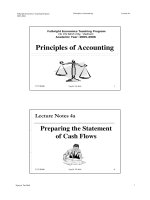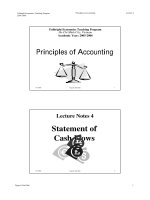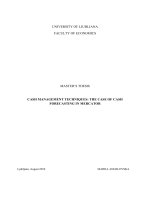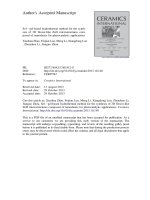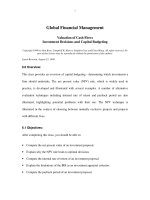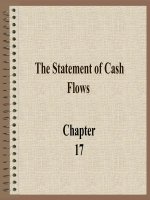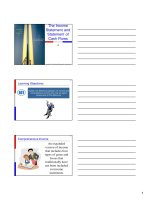Ch16 Statements of Cash Flow
Bạn đang xem bản rút gọn của tài liệu. Xem và tải ngay bản đầy đủ của tài liệu tại đây (949.18 KB, 19 trang )
<span class='text_page_counter'>(1)</span>4-1. Chapter 16. Statement of Cash Flows.
<span class='text_page_counter'>(2)</span> 4-2. Learning Objectives Describe the purpose of the statement of cash flows..
<span class='text_page_counter'>(3)</span> 4-3. The Statement of Cash Flows . Provides relevant information about a company’s cash receipts and cash disbursements.. . Helps investors and creditors to assess . . future net cash flows liquidity long-term solvency.. Required for each income statement period presented..
<span class='text_page_counter'>(4)</span> 4-4. Learning Objectives Identify and describe the various classifications of cash flows presented in a statement of cash flows..
<span class='text_page_counter'>(5)</span> 4-5. Operating Activities Inflows Inflows from: from:. Sales Salesto tocustomers. customers. Interest and dividends. Interest and dividends received. received.. +. Outflows Outflows to: to:. Purchase Purchase of of inventory. inventory. Salaries, wages, and other. Salaries, wages, and other operating operatingexpenses. expenses. Interest Intereston ondebt. debt. Income Incometaxes. taxes.. _. Cash Cash Flows Flows from from Operating Operating Activities Activities.
<span class='text_page_counter'>(6)</span> 4-6. Direct and Indirect Methods of Reporting Two Formats for Reporting Operating Activities Direct Method. Indirect Method. Reports the cash effects of each operating activity. Starts with accrual net income and converts to cash basis.
<span class='text_page_counter'>(7)</span> 4-7. Direct and Indirect Methods Direct Method. Indirect Method.
<span class='text_page_counter'>(8)</span> 4-8. Investing Activities Inflows Inflows from: from:. Sale Saleof oflong-term long-termassets assetsused usedin in. the thebusiness. business. Sale Saleof ofinvestment investmentsecurities securities (stocks (stocksand andbonds). bonds). Collection Collectionof ofnontrade nontrade receivables. receivables.. +. Outflows Outflows to: to:. Purchase Purchaseof oflong-term long-term assets assets. used usedin inthe thebusiness. business. Purchase Purchaseof ofinvestment investment securities securities(stocks (stocksand andbonds). bonds). Loans Loansto toother otherentities. entities.. _. Cash Cash Flows Flows from from Investing Investing Activities Activities.
<span class='text_page_counter'>(9)</span> 4-9. Financing Activities Inflows Inflows from: from:. Sale Saleof ofshares sharesto toowners. owners. Borrowing from creditors. Borrowing from creditors through throughnotes, notes, loans, loans, mortgages, mortgages,and andbonds. bonds.. Outflows Outflows to: to:. Owners Ownersin inthe theform form of of dividends dividends. or orother otherdistributions. distributions. Owners Ownersfor forthe thereacquisition reacquisitionof of shares sharespreviously previouslysold. sold. Creditors Creditorsas asrepayment repaymentof of the the principal principalamounts amountsof ofdebt. debt.. +. _. Cash Cash Flows Flows from from Financing Financing Activities Activities.
<span class='text_page_counter'>(10)</span> 4-10. Cash Flow Examples. - PE-16.1A (Text Book) - PE-16.1B (Text Book) - Ex-16.3 (Text Book) - Handouts.
<span class='text_page_counter'>(11)</span> 4-11. Cash Flow Examples – PE-16.1A (Text Book).
<span class='text_page_counter'>(12)</span> 4-12. Cash Flow Examples – PE-16.1B (Text Book).
<span class='text_page_counter'>(13)</span> 4-13. Cash Flow Examples – Ex-16.3 (Text Book).
<span class='text_page_counter'>(14)</span> 4-14. Learning Objectives Statement of Cash Flow Example.
<span class='text_page_counter'>(15)</span> Example 1. 4-15.
<span class='text_page_counter'>(16)</span> Example 2. 4-16.
<span class='text_page_counter'>(17)</span> 4-17. The following are the 2013 Income Statement and Comparative Balance Sheets of Dublin Enterprises($ in millions):. Income Statement For the Year Ended December 31, 2013 --------------------------------------. Revenue ……………………………………..$2,100 Cost of goods sold…………………………(1,400) Gross profit …………………………………. 700 Operating expenses: Selling and administrative …................ (355) Depreciation expense ………………….. (85) Total operating expenses ……………….. (440) Income before income taxes ……………… 260 Income tax expense …………………………… (78) Net income …………………………………….. 182.
<span class='text_page_counter'>(18)</span> 4-18. The following are the 2013 Income Statement and Comparative Balance Sheets of Dublin Enterprises($ in millions): Comparative Balance Sheets 12/31/13 12/31/12 Assets: Cash ………………………………………….. $ 300 ………………$ 220 Accounts receivable (net) ……………………227 ……………… 240 Inventory ……………………………………….160 ……………….. 120 Property, plant & equipment ……………… 960 ……………….. 800 Less: Accumulated depreciation …………(405) …………….. (320) Total assets …………………………………….1,242 ……………...1,060 Liabilities and shareholders’ equity: Accounts payable ……………………………145 ………………. 130 Selling & Administrative payables ………147 ……………….. 170 Income taxes payable ……………………… 95 ………………… 50 Long-term debt …………………………… –0– ………………. 100 Common stock …………………………………463 ……………… 400 Retained earnings ……………………………. 392 ………………. 210 Total liabilities and shareholders’ equity 1,242 …………….$1,060 (S&A: Selling & Administrative) Required: Prepare DEI’s 2013 statement of cash flows using the direct method & indirect method..
<span class='text_page_counter'>(19)</span> 4-19. End of Chapter 16.
<span class='text_page_counter'>(20)</span>
